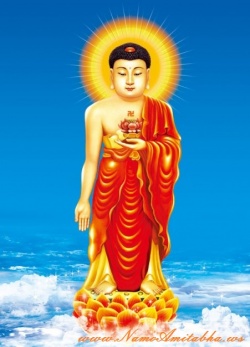Difference between revisions of "Buddhanusmrti"
| Line 1: | Line 1: | ||
[[File:Amvcation.jpg|thumb|250px|]] | [[File:Amvcation.jpg|thumb|250px|]] | ||
| − | |||
| − | |||
| − | |||
| − | Progressing to [[successively]] deeper levels of practice, one may dispense with [[recollection]] of the [[Buddha's | + | |
| + | |||
| + | "The [[word]] [[nien-fo]] ([[Buddha Recitation]]) is originally a {{Wiki|Chinese}} translation of the [[Sanskrit]] compound [[Buddhanusmrti]], meaning 'the [[recollection or the bearing in mind ([[anusmrti]]) of the [[attributes]] of a [[Buddha]].' | ||
| + | |||
| + | The [[practice of Buddhanusmrti]] itself has a long history in [[India]], extending back to well before the rise of [[Mahayana Buddhism]]... | ||
| + | |||
| + | When the term and its {{Wiki|practical}} lore were introduced to [[China]], they came as a highly developed [[meditative]] system, with ties to a diversity of [[Buddhist scriptures]] and [[deities]]. | ||
| + | |||
| + | [[Amitabha]] and the [[Pure Land sutras]] represented but one among many such systems. | ||
| + | |||
| + | The major [[Indian]] sourcos and early {{Wiki|Chinese}} treatises on [[Buddhanusmrti]] treat it as a complex practice involving several different approaches to contemplation. | ||
| + | |||
| + | At its most basic level, Buddha-mindfulness begins with [[visual]] [[recollection]] of the [[thirty-two major marks]] and eighty minor excellencies of the [[Buddha's]] glorified '[[body]] of [[form]]' ([[Sanskrit]]/[[rupa-kaya]]). | ||
| + | |||
| + | Progressing to [[successively]] deeper levels of practice, one may dispense with [[recollection]] of the [[Buddha's physical form]] and instead [[contemplate]] his [[boundless]] [[spiritual powers]] and [[omniscience]], | ||
| + | |||
| + | until one ultimately arrives at the [[Buddha's]] [[formless]] [[essence of enlightenment]] itself -- a practice known as [[mindful]] [[recollection]] of the [[Buddha's]] '[[body of truth]] or [[reality]]' ([[Sanskrit]]/[[Dharma-kaya]]). | ||
| + | |||
| + | Thus, although [[Buddhanusmrti]] may take a particular [[Buddha]] or [[Bodhisattva]] (such as [[Amitabha]]) as its starting point, it ultimately grounds itself in [[universal Mahayana truths]]. | ||
This feature [[plants]] [[Buddhanusmrti]] firmly within the {{Wiki|mainstream}} of [[Mahayana]] [[Buddhist practice]], connecting it with the [[meditations]] on [[emptiness]] that we more often associate with the [[Perfection of Wisdom]] and other less devotional [[traditions]] of [[Buddhist scriptures]]." | This feature [[plants]] [[Buddhanusmrti]] firmly within the {{Wiki|mainstream}} of [[Mahayana]] [[Buddhist practice]], connecting it with the [[meditations]] on [[emptiness]] that we more often associate with the [[Perfection of Wisdom]] and other less devotional [[traditions]] of [[Buddhist scriptures]]." | ||
| − | "An early [[form]] of [[Buddhanusmrti]] ([[Buddha Remembrance]] or [[Buddha Recitation]]) can be found in the [[Nikayas]] of the [[Pali Canon]]: 'In the [[Nikayas]], the [[Buddha]] ...advised his [[disciples]] to think of him and his [[virtues]] as if they saw his [[body]] before his [[eyes]], whereby they would be enabled to [[accumulate]] [[merit]] and attain [[Nirvana]] or be saved from transmigrating in the [[evil paths]].'" {{Wiki|D.T.Suzuki}}, The Eastern Buddhist/Vol 3, No 4 : 317 | + | "An early [[form]] of [[Buddhanusmrti]] ([[Buddha Remembrance]] or [[Buddha Recitation]]) can be found in the [[Nikayas]] of the [[Pali Canon]]: |
| + | |||
| + | 'In the [[Nikayas]], the [[Buddha]] ...advised his [[disciples]] to think of him and his [[virtues]] as if they saw his [[body]] before his [[eyes]], whereby they would be enabled to [[accumulate]] [[merit]] and attain [[Nirvana]] or be saved from transmigrating in the [[evil paths]].'" {{Wiki|D.T.Suzuki}}, The Eastern Buddhist/Vol 3, No 4 : 317 | ||
{{R}} | {{R}} | ||
[http://www.baus-ebs.org/fodict_online/entry.asp?dictid=6&entryid=8452 www.baus-ebs.org] | [http://www.baus-ebs.org/fodict_online/entry.asp?dictid=6&entryid=8452 www.baus-ebs.org] | ||
{{SanskritTerminology}} | {{SanskritTerminology}} | ||
[[Category:Buddhas]] | [[Category:Buddhas]] | ||
Revision as of 17:30, 20 March 2016
"The word nien-fo (Buddha Recitation) is originally a Chinese translation of the Sanskrit compound Buddhanusmrti, meaning 'the [[recollection or the bearing in mind (anusmrti) of the attributes of a Buddha.'
The practice of Buddhanusmrti itself has a long history in India, extending back to well before the rise of Mahayana Buddhism...
When the term and its practical lore were introduced to China, they came as a highly developed meditative system, with ties to a diversity of Buddhist scriptures and deities.
Amitabha and the Pure Land sutras represented but one among many such systems.
The major Indian sourcos and early Chinese treatises on Buddhanusmrti treat it as a complex practice involving several different approaches to contemplation.
At its most basic level, Buddha-mindfulness begins with visual recollection of the thirty-two major marks and eighty minor excellencies of the Buddha's glorified 'body of form' (Sanskrit/rupa-kaya).
Progressing to successively deeper levels of practice, one may dispense with recollection of the Buddha's physical form and instead contemplate his boundless spiritual powers and omniscience,
until one ultimately arrives at the Buddha's formless essence of enlightenment itself -- a practice known as mindful recollection of the Buddha's 'body of truth or reality' (Sanskrit/Dharma-kaya).
Thus, although Buddhanusmrti may take a particular Buddha or Bodhisattva (such as Amitabha) as its starting point, it ultimately grounds itself in universal Mahayana truths.
This feature plants Buddhanusmrti firmly within the mainstream of Mahayana Buddhist practice, connecting it with the meditations on emptiness that we more often associate with the Perfection of Wisdom and other less devotional traditions of Buddhist scriptures."
"An early form of Buddhanusmrti (Buddha Remembrance or Buddha Recitation) can be found in the Nikayas of the Pali Canon:
'In the Nikayas, the Buddha ...advised his disciples to think of him and his virtues as if they saw his body before his eyes, whereby they would be enabled to accumulate merit and attain Nirvana or be saved from transmigrating in the evil paths.'" D.T.Suzuki, The Eastern Buddhist/Vol 3, No 4 : 317
